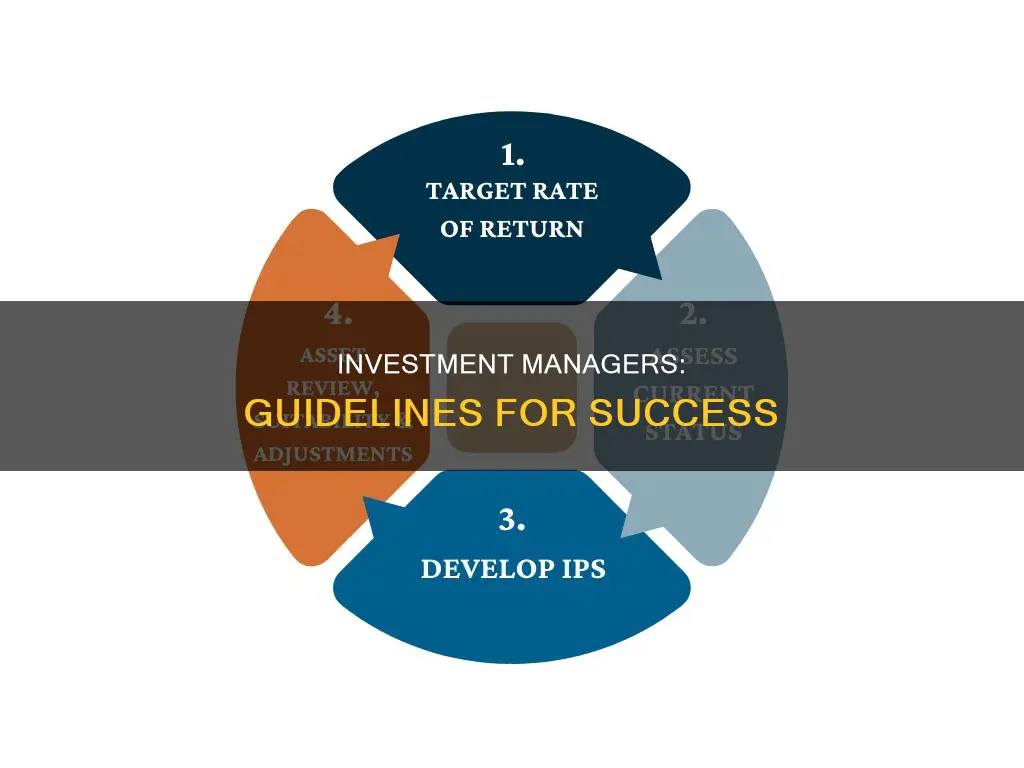
An investment policy statement (IPS) is a strategic document that outlines the rules and guidelines that a portfolio manager must follow when managing a client's investment program. It is an agreement between the portfolio manager and the client, detailing the client's investment goals and objectives, as well as the strategies that the manager will employ to achieve these objectives. The IPS provides guidance to the portfolio manager and helps to prevent emotional decision-making by the client. It serves as a roadmap for the client-financial advisor relationship and provides an objective course of action.
| Characteristics | Values |
|---|---|
| Purpose | To outline the rules and guidelines that the portfolio manager must follow when considering asset allocation in the client's portfolio. |
| Who is it drafted by? | A portfolio manager and a client |
| What does it outline? | The client's portfolio objectives and information relevant to achieving the objectives. |
| Components | Scope and purpose, governance, investment, return and risk objectives, and risk management |
What You'll Learn

Investment Policy Statement (IPS)
An Investment Policy Statement (IPS) is a strategic document used by financial advisors to outline guidelines that can help launch and manage a client's investment program. It is an agreement between a portfolio manager or financial advisor and a client that outlines the general rules and strategies that the manager should employ to meet the client's investment goals and objectives.
The IPS lays the foundation for the client-financial advisor relationship and details how the financial advisor will make investment decisions. It can be tailored to each client's financial and investment situations and perspectives, providing an objective course of action to prevent emotions from driving unwise investment decisions.
The IPS includes information on matters such as asset allocation, risk tolerance, liquidity requirements, and financial goals. It establishes a systematic review process that enables the investor to stay focused on long-term objectives, even during short-term market fluctuations.
The document also includes monitoring and control procedures to be followed by all involved in the investment process, such as the frequency of monitoring, benchmarks for portfolio return comparisons, and procedures for making future changes to the IPS.
A well-conceived IPS helps both the manager and the investor stay focused on their long-term objectives, ensuring they are on the same page regarding the investment process.
Smart Saving and Investing Strategies for Your Kids' Future
You may want to see also

Client's investment goals
An investment policy statement (IPS) is a strategic document that outlines a client's investment goals and objectives, as well as the strategies that the investment manager will employ to achieve these goals. It is a formal agreement between the portfolio manager or financial advisor and the client, providing a general roadmap for the manager's actions.
The IPS is tailored to each client's specific financial situation, investment perspectives, and goals. It covers various aspects, including:
Investment Goals and Objectives
The first section of the IPS outlines the client's broad investment goals and objectives. This includes the client's reasons for investing, such as saving for retirement or education, as well as their desired rate of return and time horizon.
Investment Strategies and Guidelines
The IPS describes the strategies and guidelines that the investment manager will follow to achieve the client's goals. This includes information on asset allocation, such as the target allocation between stocks, bonds, and other asset classes, as well as any specific sectors or industries to be included or avoided. It also covers risk management, specifying the client's risk tolerance and how it will be managed through diversification and other techniques.
Performance Monitoring and Reviews
The IPS establishes procedures for monitoring investment performance against predefined benchmarks. It specifies the frequency and format of performance reports and reviews, ensuring that the investment strategy remains aligned with the client's goals and market conditions.
Responsibilities and Control
The IPS clearly defines the roles and responsibilities of all parties involved, including the investor, financial advisor, and portfolio manager. It outlines who has the authority to make changes to the portfolio and establishes a schedule for regular reviews of the IPS, allowing for adjustments as needed.
Liquidity Requirements and Tax Strategies
The IPS also covers the client's liquidity requirements, including any short-term or long-term cash needs. Additionally, it outlines tax strategies, such as managing the portfolio as a taxable or tax-deferred account, to optimize the client's after-tax returns.
Overall, the IPS is a comprehensive document that ensures a clear understanding between the client and the investment manager, providing a strategic roadmap to guide investment decisions and helping to prevent emotionally driven, unwise choices.
Invest Less, Save More: Strategies for Financial Success
You may want to see also

Strategies to meet objectives
An investment policy statement (IPS) is a strategic document that outlines the strategies a manager should employ to meet a client's objectives. Here are some strategies that can be used to meet these objectives:
- Understanding the Client's Risk Tolerance: Risk tolerance is a critical aspect that influences the composition of the investment portfolio. It refers to an investor's willingness to endure fluctuations in an investment's value. By understanding their client's risk tolerance, investment managers can tailor their strategies accordingly. For instance, a client with a high-risk tolerance interested in growth may opt for a short-term aggressive portfolio, while a conservative investor with low-risk tolerance may focus on an income-generating portfolio.
- Asset Allocation: Asset allocation is the process of deciding how to distribute investments among different asset classes, such as stocks, bonds, real estate, or cash. A well-conceived IPS will specify the target allocation between these asset classes, ensuring that the investment strategy is aligned with the client's objectives. For example, an IPS may recommend a portfolio composed of 60% stock assets and 40% fixed-income assets for a client with a conservative risk profile.
- Diversification: Diversification is a strategy that involves spreading investments across different asset classes, sectors, industries, and geographic regions. This helps to reduce risk and improve the potential for long-term returns. By diversifying their client's portfolio, investment managers can better manage risk and increase the chances of meeting their objectives.
- Regular Review and Rebalancing: Investment objectives and strategies should be regularly reviewed and adjusted to accommodate changes in the client's financial circumstances, market conditions, or personal goals. This may involve completing an investment objective questionnaire annually or whenever a significant life event occurs. Additionally, rebalancing the portfolio on an annual basis can help maintain the desired asset allocation and minimize tax consequences.
- Tax Implications: Considering the potential tax implications of investment decisions is crucial. Certain investment strategies may be more tax-efficient than others, and understanding these implications can help maximize returns and meet the client's financial objectives. For example, contributing to a tax-advantaged retirement plan can be an effective strategy for tax minimization.
- Income and Growth: The investment objectives of income and growth play a crucial role in shaping an investor's financial portfolio. Income-driven investment strategies focus on generating a stable stream of income, typically through dividend-yielding stocks, bonds, and other income-generating assets. On the other hand, growth-oriented investment strategies prioritize capital appreciation and wealth accumulation over time, often utilizing high-potential assets such as equities, growth stocks, and market-traded funds (ETFs).
Becoming an Investment Manager: UK Pathways and Steps
You may want to see also

Risk tolerance
An investor's risk tolerance is influenced by several factors, including age, investment goals, income, future earning capacity, and the presence of other assets. For example, younger individuals are generally considered to have a higher risk tolerance as they have more time to recover from potential losses and can afford to take more risks. Similarly, investors with a larger portfolio are more tolerant of risk as the percentage loss is much less compared to a smaller portfolio.
There are typically three categories of risk tolerance: aggressive, moderate, and conservative. Aggressive investors have a higher risk tolerance and are willing to risk losing money for the potential of better returns. They tend to be market-savvy and emphasise capital appreciation over income preservation. On the other hand, conservative investors have a lower risk tolerance and seek investments with guaranteed returns, often targeting vehicles that are highly liquid and considered safe, such as bank certificates of deposit (CDs) or money market funds. Moderate investors fall between these two extremes, aiming to balance opportunities and risks with a portfolio that includes a mix of stocks and bonds.
It is important for investment managers to understand their clients' risk tolerance as it guides the types of investments made and helps to prevent emotionally driven investment decisions.
National Savings, Investment, and Their Symbiotic Relationship
You may want to see also

Liquidity requirements
An investment policy statement (IPS) is a document drafted between a portfolio manager and a client that outlines the general rules and guidelines for the manager to follow. It serves as a strategic foundation for the client-financial advisor relationship and provides an objective course of action.
IPSs typically include sections on the client's financial goals and objectives, the path or strategy the advisor will follow to achieve these goals, asset allocation, risk tolerance, and liquidity requirements.
Definition of Liquidity Requirements
Types of Liquidity Requirements
- Short-term liquidity needs: These are immediate or urgent cash requirements that the client may have. For example, an upcoming large purchase, medical expenses, or a need for liquid assets.
- Long-term liquidity needs: This refers to the client's need for liquidity over a more extended period, such as retirement planning or saving for a child's education.
- Emergency liquidity needs: This covers unexpected events, such as a job loss, a medical emergency, or a natural disaster, where the client may need quick access to cash.
- Strategic liquidity needs: These are liquidity requirements that support the client's long-term investment strategy. For example, taking advantage of investment opportunities that may require quick access to cash.
Assessing Liquidity Requirements
When determining liquidity requirements, the portfolio manager should consider the client's current financial situation, including their income, expenses, and existing assets. This analysis will help identify the client's ability to meet short-term and long-term liquidity needs. It will also help assess the level of risk the client is comfortable with regarding their liquidity position.
Strategies for Meeting Liquidity Requirements
The IPS should outline strategies for ensuring the client can meet their liquidity requirements. This may include setting aside a certain percentage of the client's portfolio in highly liquid assets, such as cash or cash equivalents. Additionally, the IPS may specify the use of lines of credit or other sources of funding to meet short-term liquidity needs without disrupting long-term investment goals.
Monitoring and Adjusting Liquidity Requirements
The IPS should also establish a process for regularly monitoring and reviewing the client's liquidity requirements. This may include assessing changes in the client's financial situation, market conditions, or investment performance. If the client's liquidity needs change significantly, the IPS should provide guidelines for adjusting the investment strategy accordingly.
In conclusion, liquidity requirements are a critical component of an investment policy statement. They outline the client's short-term and long-term cash needs and guide the portfolio manager in developing strategies to meet those needs while also pursuing the client's investment goals. A well-crafted IPS helps ensure that the client's investments remain aligned with their overall financial objectives and risk tolerance.
Saving and Investment: Understanding the Fundamentals
You may want to see also
Frequently asked questions
An investment policy statement (IPS) is a document drafted between a portfolio manager and a client that outlines the rules and guidelines that the portfolio manager must follow when considering asset allocation in the client’s portfolio.
An IPS includes the client’s broad investing goals and objectives, as well as the path the advisor will take to achieve these goals.
An IPS benefits both the portfolio manager and the client. It provides guidance to the portfolio manager when making portfolio decisions and helps the client avoid making emotional decisions related to their portfolio.
The components of an IPS include scope and purpose, governance, investment, return and risk objectives, and risk management.
An IPS is useful when a client wants to make an emotional decision about their portfolio, such as investing in a "hot" new industry. The IPS can remind the client of their overarching goals and strategies and prevent them from making a potentially harmful decision.







